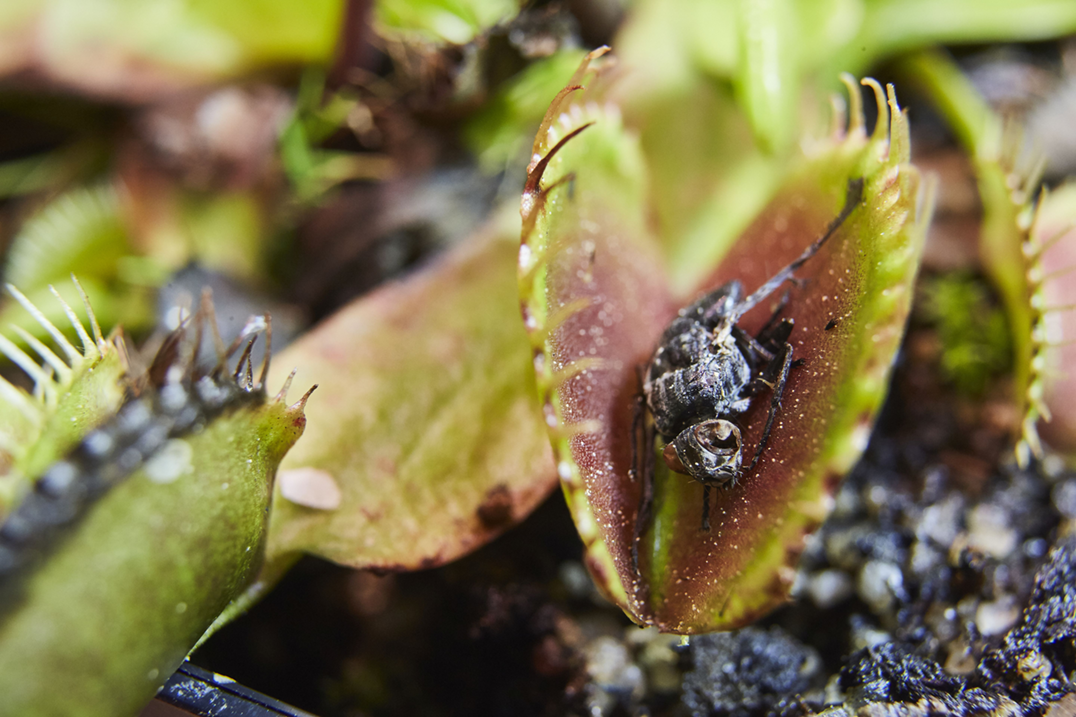News & Press
The Venus flytrap – an inspiration for technology
Advanced Science: researchers investigate movements when leaves reopen

The Venus flytrap with prey. Photo: Jens Steingässer
The rapid speed at which the carnivorous Venus flytrap catches its prey is legendary. What is less well known is that Dionaea muscipula is also capable of a variety of other forms of movement. In a study, a team at the Universities of Darmstadt, Freiburg and Stuttgart studied the opening – i.e. the “re-setting” – of the traps. The results are also interesting for technical disciplines such as mechanical engineering or soft robotics, and have just been published in the renowned journal “Advanced Science”.
The Venus flytrap is a specially protected plant species that originated from North America. If any prey animals such as flies, ants or spiders touch the leaves, they instantly snap shut. The prey is stuck – and is digested. Snapping lasts only about 100 milliseconds, one of the fastest movements in the plant kingdom, and has been extensively studied scientifically. A team led by Dr. Simon Poppinga from the Botanical Garden at TU Darmstadt, Prof. Thomas Speck and Dr. Grazyna Durak from the Botanic Garden and the cluster of excellence Living, Adaptive and Energy-autonomous Materials Systems (livMatS) at the University of Freiburg, and Prof. Manfred Bischoff from the University of Stuttgart has now addressed the hitherto little-researched question of how the traps reopen and prepare for new prey.
Also highly relevant for engineering sciences
The study used various methods such as time-lapse-based 3D deformation measurement technology, digital 3D image correlation, histological investigations of trap anatomy, and mathematical models to clarify how the traps are constructed and how they deform three-dimensionally when they reopen.
It turns out that different forms of morphologically “programmed” movement exist when the trap reopens, depending on the size and slenderness of the trap. While small traps move continuously and evenly, large traps employ comparatively quick curvature changes of their halves from convex to concave. This process is termed “snap-through”. All the forms of movement take several hours. In addition, especially large and slender traps break as they open, so it would appear likely that their size is limited. This could be one reason why there are no giant traps.
The scientists’ research shows that in addition to growth and change in the turgor – the pressure of fluid in the cells – elastic instabilities, the release of stored elastic energy, are also “used” to drive the movement in large and slender traps.
“Our study has given us a deeper understanding of the biology of the Venus flytrap,” says Dr. Simon Poppinga, head of the Botanical Gardens at TU Darmstadt and one of the lead authors of the study. However, the results are also highly relevant for engineering sciences such as mechanical engineering or soft robotics. Venus flytraps provide important impulses for biomimetic research approaches, and the principle of their snapping movement has already been transferred into numerous technical systems. “As most of the current research has focused on the snapping movement, our study of the slower and different reopening process provides extremely important information for the further development of these systems,” explains Dr. Poppinga. “Venus flytraps demonstrate how hinge-free forms of movement can be carried out at different speeds with one and the same structure.”
Biomechanics, functional morphology and biomimetics of plants
Simon Poppinga has been the new head of the Botanical Garden at TU Darmstadt since January, and his research focuses on the biomechanics, functional morphology and biomimetics of plants. One focus is on movable structures. These include seed dispersing apparatuses such as capsules and cones as well as the traps of carnivorous plants. For this purpose, the garden at Darmstadt is planning its own research projects in the near future. The detailed basic research on mechanically and structurally highly complex plant systems shows the relevance of organismic research, and underlines the important contribution of scientific collections such as the Botanical Gardens.
Original Publication:
Durak GM, Thierer R, Sachse R, Bischoff M, Speck T, Poppinga S (2022) Smooth or with a snap! Biomechanics of trap reopening in the Venus flytrap (Dionaea muscipula). Advanced Science 2022, 2201362. DOI: 10.1002/advs.202201362
Press Release of TU Darmstadt
